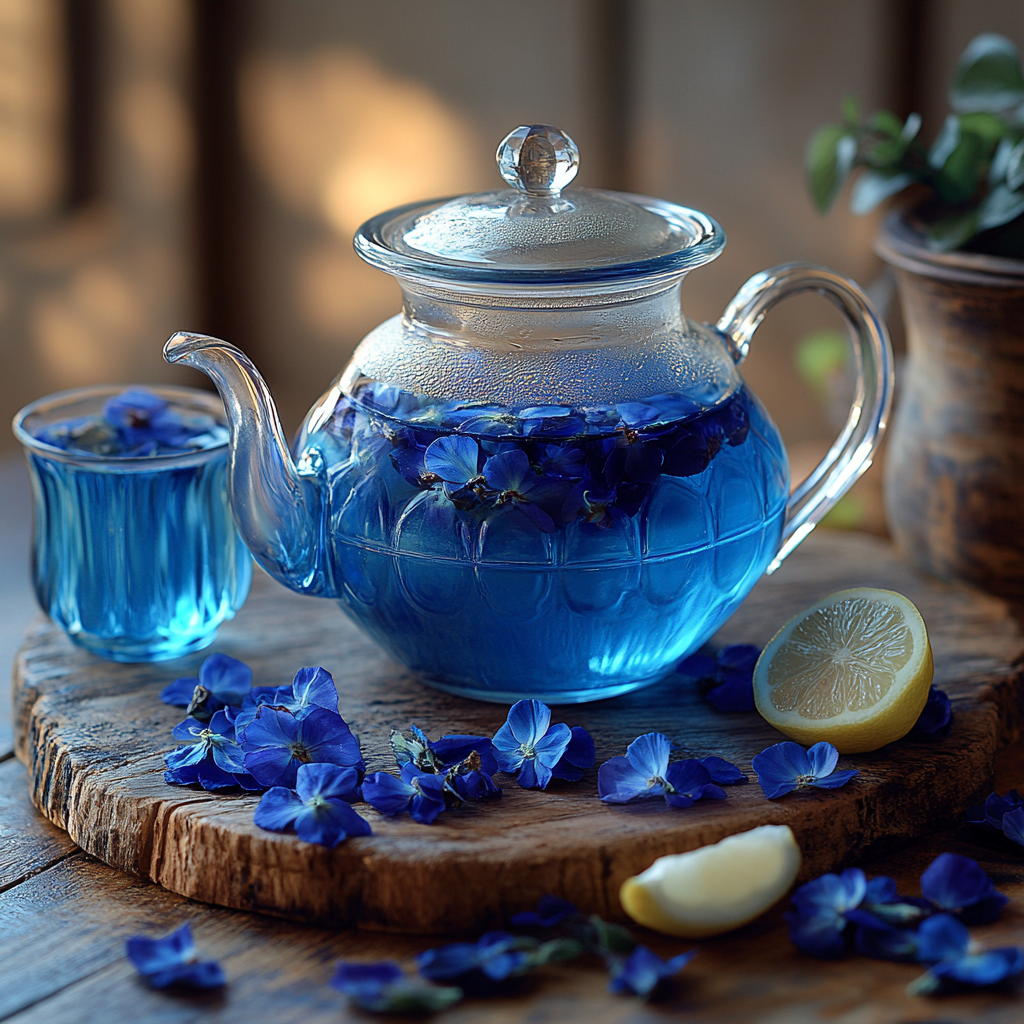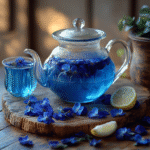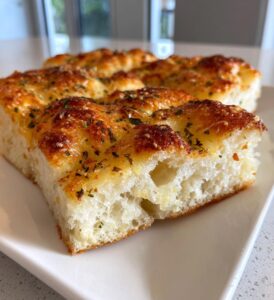Introduction to Butterfly Pea Flower Tea
Butterfly pea flower tea is more than just a striking blue beverage—it’s a caffeine-free herbal infusion made from the petals of Clitoria ternatea, a plant native to Southeast Asia. Known for its vibrant indigo hue and subtle earthy flavor, this tea has been treasured for centuries in Thai, Malaysian, and Ayurvedic traditions. In recent years, it’s gained global popularity not only for its Instagram-worthy color-changing magic but also for its potential wellness benefits.
The drink’s natural pigments, called anthocyanins, are what make the tea turn from blue to purple when you add acidic ingredients like lemon juice. This fascinating chemical reaction has turned it into a favorite among home brewers, mixologists, and wellness enthusiasts alike.
Beyond aesthetics, butterfly pea flower tea has been linked to antioxidant protection, improved skin health, and even support for brain function. From traditional herbal medicine to trendy cafés, it’s now recognized as a versatile drink that can be enjoyed hot, cold, or blended into creative recipes.
If you’re curious about unique, healthy beverages, discover great ideas like Lavender Matcha Latte Recipe for another calming and colorful tea option.

In the next section, we’ll explore exactly why butterfly pea flower tea is good for you, digging into its health benefits and scientific research.
Health Benefits of Butterfly Pea Flower Tea
Antioxidant and Anti-inflammatory Properties
One of the biggest reasons butterfly pea flower tea has captured attention in the wellness world is its impressive antioxidant profile. The vibrant blue color comes from anthocyanins—plant compounds that help fight oxidative stress in the body. Oxidative stress, caused by free radicals, can damage cells and contribute to aging and chronic illnesses. Regularly sipping this herbal tea may help support your body’s natural defenses.
Alongside antioxidants, the tea contains flavonoids and other phytochemicals that may reduce inflammation. This makes it an appealing choice for those looking to support overall health with natural, plant-based remedies.
Potential Cognitive and Brain Health Support
Traditional Ayurvedic medicine has long used Clitoria ternatea to enhance memory and learning. Modern studies suggest that compounds in butterfly pea flower may increase acetylcholine levels in the brain, a neurotransmitter linked to learning and memory retention. While more human research is needed, early findings are promising, and incorporating this tea into your routine could be a delicious way to nurture brain health over time.
Looking for inspiration? Try the Apple Cider Vinegar Tonic for another antioxidant-rich beverage to boost your wellness routine.
Everyday Uses – Is It Safe to Drink Daily?
Recommended Daily Intake
For most healthy adults, drinking butterfly pea flower tea daily is considered safe in moderate amounts—typically 1 to 2 cups per day. Since it’s naturally caffeine-free, it won’t disrupt your sleep or cause the jitters that coffee and some teas can trigger. Many people enjoy a morning cup for its soothing properties, while others prefer it in the evening as a calming ritual.
If you’re brewing it for the first time, start with a light infusion—about 4–5 dried flowers per cup of hot water—and adjust the strength to your taste. You can enjoy it plain, sweetened with honey, or mixed with other herbs for added flavor and benefits.
Long-term Wellness Benefits
Consuming butterfly pea flower tea regularly may help support hydration, provide a steady source of antioxidants, and offer gentle stress relief. Because it’s low in calories and free of artificial additives, it fits easily into most diets, including vegan, keto, and gluten-free lifestyles.
However, just like any herbal remedy, balance is key. Overconsumption—more than 3–4 cups daily—might lead to mild stomach upset in some individuals, so moderation is the best approach.
Don’t miss our Chocolate Banana Overnight Oats recipe for another simple way to add nutrient-rich foods to your daily wellness habits.
Side Effects and Precautions
Possible Adverse Reactions
For most people, butterfly pea flower tea is well tolerated and safe. However, like any herbal drink, some individuals may experience mild side effects. The most common is a slight stomach discomfort or nausea if consumed in excessive quantities. Drinking overly strong brews—using too many flowers—can also lead to digestive irritation.
While rare, allergic reactions are possible, particularly in people sensitive to legumes, since Clitoria ternatea belongs to the pea family. If you notice skin rashes, itching, or swelling after drinking the tea, discontinue use and consult a healthcare provider.
Who Should Avoid Drinking It?
Pregnant or breastfeeding women should exercise caution, as there’s limited research on the tea’s safety during these stages. Likewise, those taking medications for blood clotting or blood pressure should check with their doctor before adding butterfly pea flower tea to their diet, as its mild vasodilating effects could interact with certain drugs.
Individuals with a history of low blood pressure may also want to monitor their reaction, since the tea has been reported to slightly lower blood pressure in some cases.
Butterfly Pea Flower Tea and Sleep
Does Butterfly Pea Flower Tea Make You Sleepy?
While butterfly pea flower tea doesn’t contain any sedatives, many people find it relaxing thanks to its caffeine-free nature and smooth, earthy flavor. Drinking it in the evening can help you unwind and signal your body that it’s time to rest. This effect is more about creating a calming ritual than inducing drowsiness, so don’t expect it to knock you out like chamomile or valerian root might.
Some researchers believe its antioxidant and mild anti-inflammatory properties may indirectly support better sleep by reducing stress and promoting overall well-being. The gentle relaxation it offers can be particularly helpful if you pair it with other nighttime wind-down habits, like dimming lights or meditating.
Best Time of Day to Drink It
You can enjoy butterfly pea flower tea at any time of the day. In the morning, it can be a refreshing, hydrating start without the caffeine crash. In the afternoon, it offers a mindful break that won’t disrupt your productivity. And in the evening, it’s a soothing choice to enjoy warm, perhaps with a splash of lemon for the color-changing effect.
For the most calming results, sip it about an hour before bed as part of your nightly routine.
Nutritional Profile and Active Compounds
Anthocyanins and Their Role in Health
The star compounds in butterfly pea flower tea are anthocyanins—natural plant pigments that give the tea its vivid blue hue. Anthocyanins are a type of flavonoid known for their antioxidant properties, which help combat oxidative stress and may lower the risk of chronic illnesses. They also have anti-inflammatory benefits and may contribute to heart health by supporting healthy blood vessels.
The tea’s unique color-changing ability comes from these pigments’ sensitivity to pH levels. Adding an acidic ingredient like lemon juice alters the anthocyanin structure, shifting the tea’s color from blue to purple—a transformation that’s as fun as it is fascinating.
Vitamins and Minerals in the Tea
While butterfly pea flower tea is not a significant source of macronutrients, it does contain trace amounts of beneficial vitamins and minerals. These include:
| Nutrient | Potential Role in Health |
|---|---|
| Vitamin E | Skin health and cell protection |
| Vitamin C | Immune support and collagen production |
| Magnesium | Muscle relaxation and nerve function |
| Potassium | Electrolyte balance and heart function |
These nutrients, combined with the tea’s plant-based antioxidants, make it a smart addition to a balanced wellness routine. And since it’s naturally sugar-free and calorie-free, it’s an excellent choice for those managing weight or blood sugar levels.
How to Make Butterfly Pea Flower Tea
Traditional Brewing Method
Making butterfly pea flower tea is simple, but there are a few tips to bring out its best flavor and color:

Ingredients:
- 4–5 dried butterfly pea flowers (per cup of water)
- 1 cup hot water (not boiling)
- Optional: honey or natural sweetener
Steps:
- Heat water to about 200°F (just below boiling).
- Add the dried flowers to a teapot or cup.
- Pour the hot water over the flowers.
- Steep for 5–10 minutes, depending on desired strength.
- Strain, sweeten if desired, and enjoy hot or iced.
The resulting brew should be a deep, sapphire blue. For a lighter taste, reduce the steeping time to 3–4 minutes.
Iced and Flavored Variations
For a refreshing twist, prepare a concentrated tea and pour it over ice. You can also experiment with flavor combinations:
- Lemon twist – Add a squeeze of lemon to watch the tea turn a beautiful purple.
- Mint infusion – Brew with a few fresh mint leaves for a cooling touch.
- Ginger blend – Add slices of ginger for a spicy-sweet flavor.
These variations not only enhance the flavor but can also boost the health benefits, making your tea both beautiful and functional.
Print
Butterfly Pea Flower Tea: Benefits, Side Effects, and How to Enjoy It
- Total Time: 12 minutes
- Yield: 1 cup 1x
- Diet: Vegan
Description
A vibrant caffeine-free herbal tea made from Clitoria ternatea flowers, celebrated for its striking blue hue, subtle earthy taste, and potential health benefits.
Ingredients
- 4–5 dried butterfly pea flowers (per cup of water)
- 1 cup hot water (about 200°F)
- Optional: honey or natural sweetener
Instructions
- Heat water to about 200°F (just below boiling).
- Add the dried flowers to a teapot or cup.
- Pour the hot water over the flowers.
- Steep for 5–10 minutes, depending on desired strength.
- Strain and sweeten if desired.
- Enjoy hot or pour over ice for a refreshing drink.
Notes
For a color-changing effect, add a squeeze of lemon juice to turn the tea from blue to purple. Can also be infused with mint, ginger, or blended with other herbal teas.
- Prep Time: 2 minutes
- Cook Time: 10 minutes
- Category: Beverage
- Method: Steeping
- Cuisine: Southeast Asian
Keywords: butterfly pea flower tea, herbal tea, caffeine-free, color changing tea
Pairing Butterfly Pea Flower Tea with Other Ingredients
Lemon for Color-Changing Effect
One of the most captivating features of butterfly pea flower tea is its ability to change color when you add an acidic ingredient, like lemon juice. This transformation from deep blue to vibrant purple isn’t just fun—it also slightly alters the flavor, giving the tea a refreshing citrus tang. This makes it a great choice for themed drinks, party cocktails, or simply impressing guests with a little natural magic.
To achieve the effect, brew the tea as usual, then add lemon juice slowly while stirring. You can adjust the amount to balance the flavor and color intensity.
Combining with Herbal Teas for Added Benefits
Butterfly pea flower tea pairs well with many other caffeine-free herbal teas. For example:
- Chamomile – Enhances relaxation and supports restful sleep.
- Hibiscus – Boosts antioxidant levels and adds a tart, cranberry-like flavor.
- Lemongrass – Adds a bright, citrusy aroma with digestive benefits.
Mixing the flowers with green tea or white tea can also create a gentle caffeine lift, while still delivering antioxidants. Experimenting with blends allows you to tailor the tea to your taste and wellness goals.
Butterfly Pea Flower Tea FAQs
What is butterfly pea flower tea good for?
Butterfly pea flower tea is valued for its antioxidant properties, potential brain health support, and calming effects. It’s also caffeine-free, making it a great alternative to coffee or black tea. Many people drink it to promote relaxation, hydration, and a bit of daily color-changing fun.
Is it safe to drink butterfly pea flower tea every day?
Yes, for most healthy adults, drinking 1–2 cups daily is safe. It’s naturally caffeine-free and low in calories, so it fits into many wellness routines. Just avoid overconsumption (more than 3–4 cups) to prevent possible digestive discomfort.
What are the side effects of butterfly pea flower tea?
Side effects are rare but may include mild stomach upset if consumed in large amounts. Allergic reactions are possible for those sensitive to legumes. Pregnant or breastfeeding women, and people taking certain medications, should consult a doctor before drinking it regularly.
Does butterfly pea flower tea make you sleepy?
It doesn’t directly induce sleep, but it can help you relax thanks to its caffeine-free nature and soothing taste. Drinking it in the evening may support a calmer mood, making it easier to wind down before bedtime.
Conclusion
Butterfly pea flower tea is more than a beautiful drink—it’s a caffeine-free, antioxidant-rich infusion with potential benefits for brain health, stress reduction, and overall wellness. Whether you enjoy it hot, iced, or blended with other herbs, it’s a versatile beverage that can fit easily into your daily routine.
From its stunning color-changing magic to its gentle, calming nature, this Southeast Asian tradition has found a home in modern kitchens around the world. Just remember to drink it in moderation, experiment with flavor pairings, and savor the experience.
Looking for inspiration? Try our Lavender Matcha Latte Recipe for another vibrant, health-boosting tea you can make at home.
For daily recipes you can follow me on Facebook and Pinterest.


